Translate this page into:
Comparison of clinical efficacy of topical tazarotene 0.1% cream with topical clobetasol propionate 0.05% cream in chronic plaque psoriasis: A double-blind, randomized, right-left comparison study
Correspondence Address:
Joe S Angelo
Department of Dermatology, SLR and TC, Karigiri, Vellore - 632106
India
| How to cite this article: Angelo JS, Kar BR, Thomas J. Comparison of clinical efficacy of topical tazarotene 0.1% cream with topical clobetasol propionate 0.05% cream in chronic plaque psoriasis: A double-blind, randomized, right-left comparison study. Indian J Dermatol Venereol Leprol 2007;73:65 |
Abstract
Background: No controlled data is available till date comparing topical tazarotene and clobetasol in Indian psoriatic patients. Objective: The aim was to compare the clinical efficacy of 12 weeks of once-daily tazarotene 0.1% cream with that of once-daily clobetasol propionate 0.05% cream in the treatment of patients with chronic plaque psoriasis. Methods: About 36 patients with bilaterally symmetrical lesions were enrolled in this double-blind randomized controlled study. A left-right randomized study was conducted. Results: Clobetasol cream was better than tazarotene cream in reducing the erythema throughout the treatment period with statistically significant differences favoring clobetasol at weeks 2, 4, 6 and 8 ( P <0.05). Tazarotene was better in reducing the induration at weeks 2 ( P <0.05), 4, 10 and 12. Clobetasol cream was better in reducing the scaling throughout the treatment period with statistically significant differences favoring clobetasol over the entire treatment period. Treatment success rate was 100% with clobetasol and 88% with tazarotene at the end of week 12 with clobetasol achieving 100% success rate at the end of week 6. Treatment with tazarotene resulted in uniform reduction of plaque elevation and was not associated with the development of hot spots. Conclusion: Topical tazarotene 0.1% cream is less effective than topical clobetasol propionate 0.05% cream in the treatment of plaque psoriasis. It has more effect on induration than on erythema and scaling of psoriatic lesions.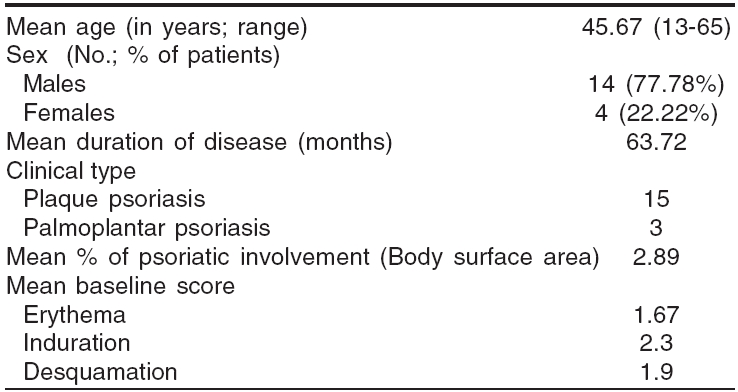

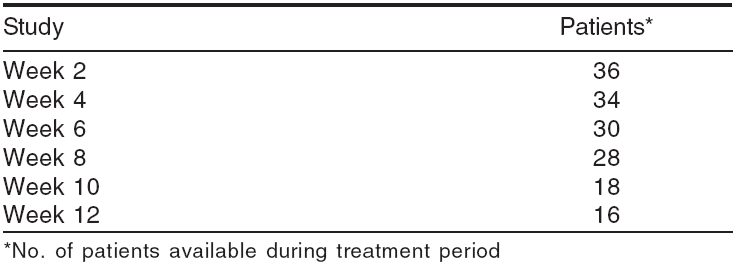

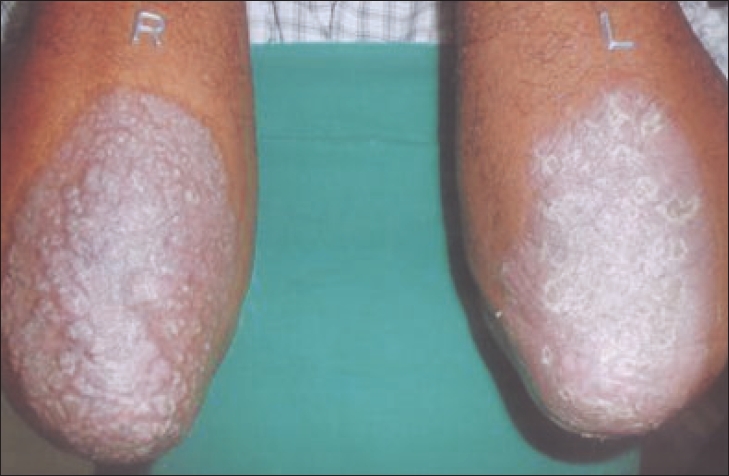 |
| Photograph showing decreased induration and scaling on both sides but development of �hot spots� on the clobetasol-treated side (right) in the same patient |
 |
| Photograph showing decreased induration and scaling on both sides but development of �hot spots� on the clobetasol-treated side (right) in the same patient |
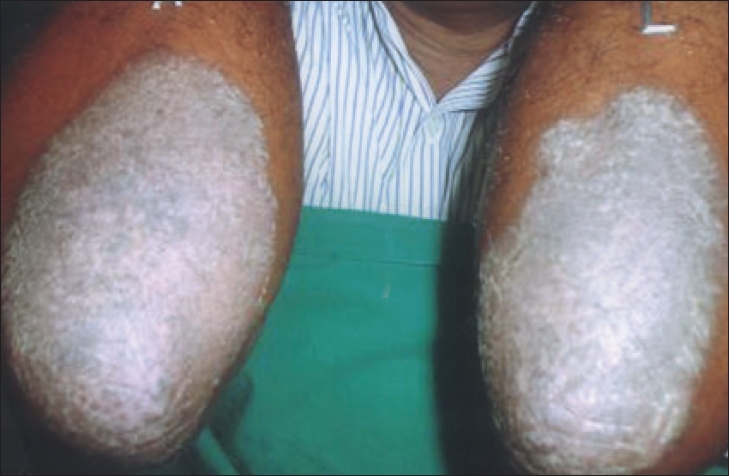 |
| Baseline photograph of a patient with chronic plaque lesions over both elbows |
 |
| Baseline photograph of a patient with chronic plaque lesions over both elbows |
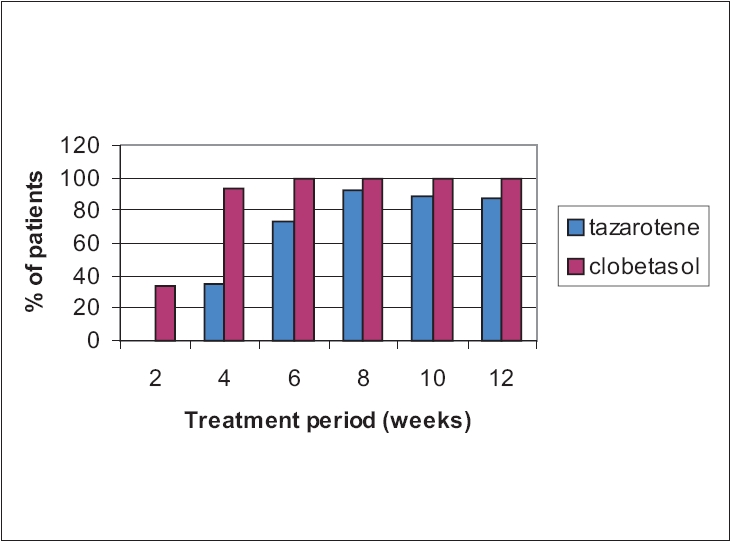 |
| Treatment success |
 |
| Treatment success |
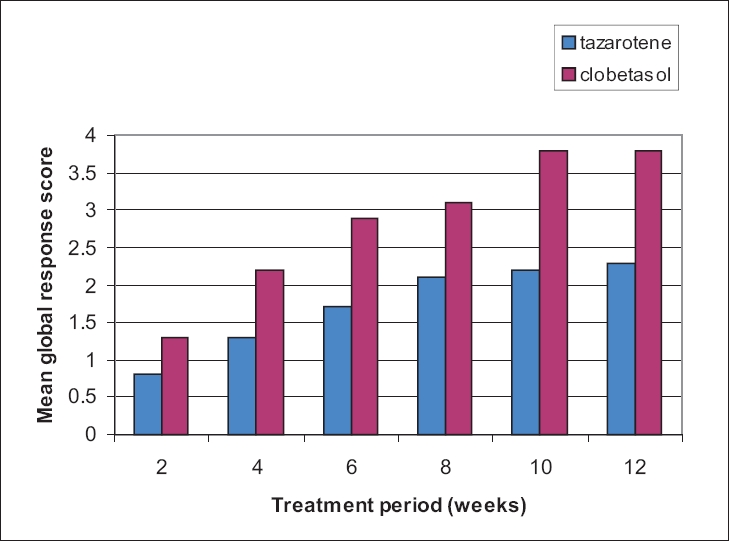 |
| Mean global response score |
 |
| Mean global response score |
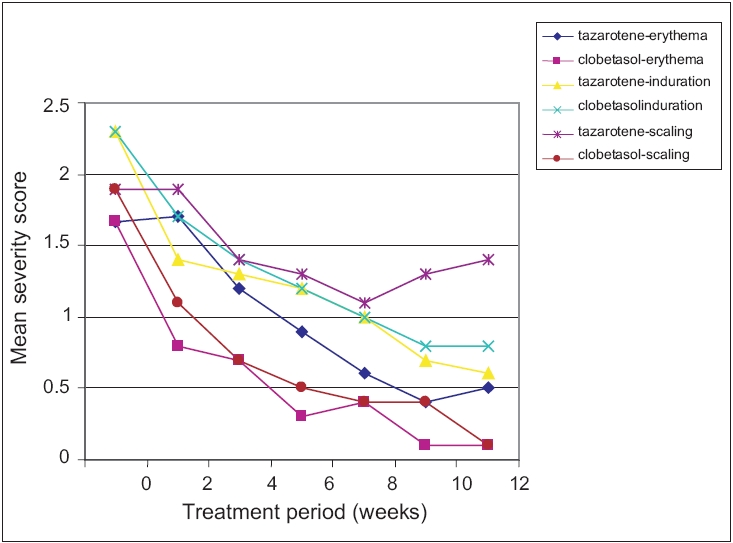 |
| Baseline demographic details of evaluable patients |
 |
| Baseline demographic details of evaluable patients |
Introduction
Psoriasis affects approximately 2% of the population.[1] There are several types of the disease including plaque, guttate, palmar/ plantar, and pustular psoriasis. Plaque psoriasis is most commonly found on the knees, elbows, scalp, and sites of trauma. The majority of patients with psoriasis have mild or limited psoriasis which is generally defined as < 20% body involvement.[2] Currently available topical therapies for psoriasis include emollients, keratolytics, coal tar, corticosteroids, anthralin, and calcipotriol. Of these, corticosteroids are probably the most commonly prescribed, but they do not have a sustained effect[3] and are associated with local adverse effects such as striae and atrophy and systemic effects. Tazarotene is the first receptor-selective retinoid for the topical treatment of plaque psoriasis.[4] On application, tazarotene is rapidly hydrolyzed to its main metabolite, tazarotenic acid, which binds to retinoic acid receptors (RARs) in the nucleus. Tazarotenic acid selectively binds to RARs b and g and exhibits little affinity for retinoid X receptors.[5] The predominant type of RAR expressed in the human epidermis is RAR, indicating that it may be an important mediator of retinoid action in skin. By regulating gene transcription, tazarotene normalizes abnormal keratinocyte differentiation, reduces epidermal hyperproliferation, and decreases inflammation, the three pathogenic factors in psoriasis, thereby producing a more normal expression of skin differentiation in psoriatic lesions.[6]
This study compares the clinical efficacy of topical tazarotene 0.1% cream with clobetasol propionate 0.5% cream in stable plaque psoriasis.
Methods
It was a randomized single-blind study. Patients were treated on an outpatient basis. Written informed consent was obtained from each patient.
A total of 36 psoriasis patients with bilaterally symmetrical lesions who attended our outpatient clinic from September 2003 to March 2005 fulfilling the enrolment criteria were included in the study. The diagnosis of psoriasis was made on clinical grounds. The inclusion criteria were those patients with stable plaque psoriasis (i.e., stable in severity and extent for at least two weeks prior to inclusion in the study) and palmoplantar psoriasis, involvement of less than 20% of the body surface area, willingness for follow-up and adherence to the protocol. The exclusion criteria were extensive psoriasis involving more than 20% of the body surface area, any topical therapy except bland emollients two weeks prior to inclusion in the study, administration of systemic therapy for psoriasis or intralesional therapy or UV radiation for at least two months prior to inclusion in the study, those with psoriatic lesions on the face, scalp and flexures, pregnant and lactating women, women of childbearing age who have not undergone sterilization operation, children of 12 years and less than 12 years of age. A detailed history, general examination, systemic examination and dermatological examination was done.
A left-right randomized study was conducted in which patients applied 0.1% tazarotene cream on one side and 0.5% clobetasol propionate cream on the other side for 12 weeks. The patients applied a thin layer of study medication to the psoriatic lesions, once daily in the evening. Application to normal skin was avoided. Study medications were applied after the skin had dried if the patient bathed or showered in the evening. Patients were advised to avoid excessive sun exposure. During the study period, other local or systemic medications were not permitted. In the event of local irritation, only liquid paraffin was permitted.
Clinical evaluation of psoriasis was made at weeks 0, 2, 4, 6, 8, 10 and 12.(16)0 The plaques were graded for erythema, scaling and induration on a 4-point scale as follows: 0- absent, 1-minimal, 2-moderate and 3-severe. This grading was done separately for upper extremities, trunk and lower extremities. For each criterion, the mean score for the three body areas was used for statistical analysis. To evaluate the overall response of psoriasis to therapy, a global score was determined at each visit, based on an overall assessment of the patient′s psoriasis including extent as well as severity in comparison with the clinical condition at week 0. -1 - Deterioration, 0 - No change, 1 - Slight improvement (~25%), 2 - Moderate improvement (~50%), 3 - Marked improvement (~75%) and 4 - Almost cleared. After the completion of treatment or complete clearing, whichever was earlier, patients were asked to apply only bland emollients and were followed for four weeks. Treatment success rate was defined as percentage of patients with a moderate improvement, marked improvement or almost cleared (about 50% improvement to almost cleared). Clinical photographs were taken for selected cases.
For statistical analysis of investigator′s assessment and erythema, induration and scaling scores during subsequent visits the t-test for equality of means was used. Pearson Chi-square test and Fischer′s exact test was used to compare the treatment success and adverse effects. A P -value of less than 0.05 was considered significant. The data was analyzed using SPSS (statistical package for social scientists) software and Epi-Info.
Results
The study cohort is shown in [Table - 1]. The demographic details of the patients are presented in [Table - 2]. There was no statistically significant difference in the demographic details between the tazarotene and clobetasol group.
Two patients developed severe irritant reaction with tazarotene and were released from the study at week 2. One patient deteriorated in the tazarotene group at week 10. During the posttreatment period, six patients came for follow-up until week 16 and other patients were lost to follow-up for unknown reasons.
Erythema
The changes in erythema at weeks 2, 4, 6, 8, 10 and 12 from the baseline are shown in [Figure - 1]. During the 12-week treatment period both tazarotene cream and clobetasol cream were associated with reduction in erythema scores from the baseline except at week 2 where tazarotene showed no improvement. At week 2, two patients in the tazarotene group developed severe irritant reaction and were released from the study. Clobetasol cream was better than tazarotene cream in reducing the erythema throughout the treatment period with statistically significant differences favoring clobetasol over tazarotene at weeks 2, 4, 6 and 8.
Induration
The changes in induration at Weeks 2, 4, 6, 8, 10 and 12 from baseline are shown in [Figure - 1]. During the 12-week treatment period, both tazarotene and clobetasol creams were associated with reduction in induration scores from baseline. Tazarotene was better than clobetasol in reducing the induration at weeks 2, 4, 10 and 12. The difference was statistically significant at week 2. Both were equally effective at weeks 6 and 8.
Scaling
The changes in scaling at weeks 2, 4, 6, 8, 10 and 12 from the baseline are shown in [Figure - 1]. During the 12-week treatment period both tazarotene and clobetasol creams were associated with reduction in desquamation scores from baseline except at week 2 where tazarotene showed no reduction. Clobetasol cream was better than tazarotene cream in reducing the scaling throughout the treatment period with statistically significant differences favoring clobetasol over tazarotene over the entire 12-week treatment period. There was an increase in scaling with tazarotene at Weeks 10 and 12 when compared to week 8.
Investigators′ overall assessment
The investigators′ overall assessment at weeks 2, 4, 6, 8, 10 and 12 is shown in [Figure - 2]. The overall improvement at Weeks 2, 4, 6, 8, 10 and 12 for tazarotene was ~20%, ~33%, ~43%, ~53%, ~55% and ~58% respectively and for clobetasol was ~33%, ~55%, ~73%, ~78%,~95% and ~95% respectively. Statistically significant differences favored clobetasol cream over tazarotene cream over the entire 12-week treatment period.
Treatment success
The treatment success rates at weeks 2, 4, 6, 8, 10 and 12 are shown in [Figure - 3]. Clobetasol produced higher success rates than tazarotene over the 12-week treatment period. Statistically significant differences favored clobetasol over tazarotene at weeks 2 and 4. Treatment success rate was 100% at Week 6 with clobetasol and was 73% with tazarotene. At week 12, it was 100% with clobetasol and 88% with tazarotene.
Posttreatment period
During the posttreatment period, six patients came for follow-up until week 16. Treatment with tazarotene was associated with reduction in erythema scores from week 12 over posttreatment phase. Treatment with clobetasol showed no change at week 16. For induration, tazarotene was associated with reduction in score from week 12. With clobetasol the score increased over the posttreatment phase from week 12. Clobetasol was associated with increase in the scaling scores over the posttreatment phase. Tazarotene showed no change at week 16. The investigators′ overall assessment of the improvement was ~58% and ~75% for tazarotene at Weeks 12 and 16 respectively and for clobetasol were ~95% and ~82% respectively. Tazarotene showed improvement at week 16 while clobetasol-treated lesions deteriorated during the posttreatment period in available compliant patients.
Adverse effects
Adverse effects were seen in seven patients (19.4%) with tazarotene and 10 patients (27.8%) with clobetasol. The common side-effect was local irritation in six patients (16.7%) treated with tazarotene. Irritation was mild in severity except in two patients. One patient developed fissuring with tazarotene. With clobetasol, the common side-effect was hypopigmentation which was seen in seven patients (19.4%). Skin atrophy was seen in three patients (8.3%) treated with clobetasol.
Discussion
Therapeutic trials using topical antipsoriatics are many. Different studies use different scoring system for evaluation. However, the results of our study were compared with an almost similar study by Lebwohl et al ., where once daily tazarotene gel was compared with twice daily fluocinonide[7] though the sample size in our study is smaller compared to their study.
In our study, during the 12-week treatment period both tazarotene cream and clobetasol cream were associated with reduction in erythema scores from the baseline except at week 2 where tazarotene showed no improvement. Clobetasol cream was better than tazarotene cream in reducing the erythema throughout the treatment period with statistically significant differences favoring clobetasol over tazarotene at weeks 2, 4, 6 and 8. In the study by Lebwohl et al ., significant differences favored fluocinonide over tazarotene in reducing erythema throughout the 12-week treatment period. With respect to scaling, our study showed that clobetasol cream was better than tazarotene cream in reducing the scaling throughout the treatment period with statistically significant differences favoring clobetasol over tazarotene over the entire treatment period. In the study by Lebwohl et al , tazarotene was similar to fluocinonide in reducing scaling at weeks 8 and 12. But statistically, differences favored fluocinonide over tazarotene till week 4. During the 12-week treatment period, both tazarotene and clobetasol creams were associated with reduction in induration scores from baseline. Tazarotene was better than clobetasol in reducing the induration at weeks 2, 4, 10 and 12. The difference was statistically significant at week 2. In study by Lebwohl et al , statistically significant differences favored fluocinonide at week 1. But treatment with clobetasol resulted in marked improvement at the end of the treatment period while tazarotene showed only moderate improvement and the differences were statistically significant over the entire treatment period. In the study by Lebwohl et al , by week 12, treatment success rates were 65% with tazarotene and 66% with fluocinonide. The differences between our study and the study by Lebwohl et al . could be due to the small sample size in our study and clobetasol being more potent than fluocinonide.[8] In another study by Weinstein et al . where tazarotene was compared with vehicle, treatment success rate was 70% with tazarotene at week 12.[4]
During the posttreatment period, because of small sample size the data for recurrence of psoriasis with both drugs is limited. However, with the available small number of patients it was noted that those treated with tazarotene continued to improve while in those treated with clobetasol, the lesions reappeared.
Most tazarotene-related adverse effects involved only mild local irritation, which was consistent with the effects of a topical retinoid. The irritation was common in the initial weeks of the study. Steroid-induced hypopigmentation and atrophy were seen in seven and three patients respectively. Taking into consideration the side-effect profile, tazarotene may be a better option for those who require long-term treatment with topical antipsoriatics.
In our study, tazarotene was more effective in reducing the induration than the scaling and erythema of psoriatic lesions [Figure - 4],[Figure - 5]. Treatment with clobetasol was associated with the development of hot spots [Figure - 5]. Hot spots are the guttate papules present within and at the border of the plaque which tend to persist and are steroid-resistant.[9] It is suggested that the psoriagenic stimulus is greater within the steroid-resistant hot spots. In our study, we found that treatment with tazarotene resulted in uniform reduction of plaque elevation and was not associated with the development of hot spots. This may be the reason for sustained posttreatment response with tazarotene and reappearance of lesions with clobetasol. As the overall improvement takes into consideration erythema and scaling in addition to induration, clobetasol showed marked improvement while tazarotene showed only moderate improvement at the end of the study even though tazarotene was observed to improve the induration better. Thus, even though topical tazarotene 0.1% cream is effective as monotherapy for plaque psoriasis, it is less effective than topical clobetasol 0.05% cream.
In summary, topical tazarotene 0.1% cream is less effective than topical clobetasol propionate 0.05% cream in the treatment of plaque psoriasis. Topical tazarotene has more effect on induration than on the erythema and scaling of psoriatic lesions. Topical tazarotene therapy is not associated with the development of hot spots. So there appears to be less chance of recurrence after stopping the drug. The safety profile of tazarotene is better than that of clobetasol for prolonged use.
| 1. |
Elder JT, Nair RP, Guo SW, Henseler T, Christophers E, Voorhees JJ, et al . The genetics of psoriasis. Arch Dermatol 1994; 130:216-24.
[Google Scholar]
|
| 2. |
Weinstein GD.Safety,Efficacy and duration of thereupatic effect of tazarotene used in the treatment of plaque psoriasis. Br J Dermatol 1996; 49:S32- S36.
[Google Scholar]
|
| 3. |
Liem WH, McCullough JL, Weinstein GD. Is topical therapy effective for psoriasis? Results of a survey of U.S. dermatologists. Clin Res 1992;40:495A.
[Google Scholar]
|
| 4. |
Weinstein GD, Krueger GG, Lowe NJ, Duvic M, Friedman DJ, Jegasothy BV, et al . Tazarotene gel, a new retinoid, for topical therapy of psoriasis: Vehicle-controlled study of safety, efficacy, and duration of therapeutic effect. J Am Acad Dermatol 1997;37:85-92.
[Google Scholar]
|
| 5. |
Chandraratna RAS. Tazarotene-first of a new generation of receptor-selective retinoids. Br J Dermatol 1996;135:18-25.
[Google Scholar]
|
| 6. |
Esgleyes-Ribot T, Chandraratna RAS, Lew-Kaya DA, Sefton J, Duvic M. Response of psoriasis to a new topical retinoid, AGN 190168. J Am Acad Dermatol 1994;30:581-90.
[Google Scholar]
|
| 7. |
Lebwohl M, Ast E, Callen JP, Cullen SI, Hong SR, Kulp-Shorten CL, et al . Once daily tazarotene gel versus twice- daily fluocinonide cream in the treatment of plaque psoriasis. J Am Acad Dermatol 1998;38:705-11.
[Google Scholar]
|
| 8. |
Jegasothy B, Jacobson C, Levine N, Millikan L, Olsen E, Pinnell S, et al . Clobetasol propionate versus flocinonide cream in psoriasis and eczema. Int J Dermatol 1985;24:461-5.
[Google Scholar]
|
| 9. |
Griffin TD, Lattanand A, VanScott EJ. Clinical and Histologic Heterogeneity of psoriatic plaques- Therapeutic relevance. Arch Dermatol 1988;124:216-21.
[Google Scholar]
|
Fulltext Views
3,897
PDF downloads
2,597





